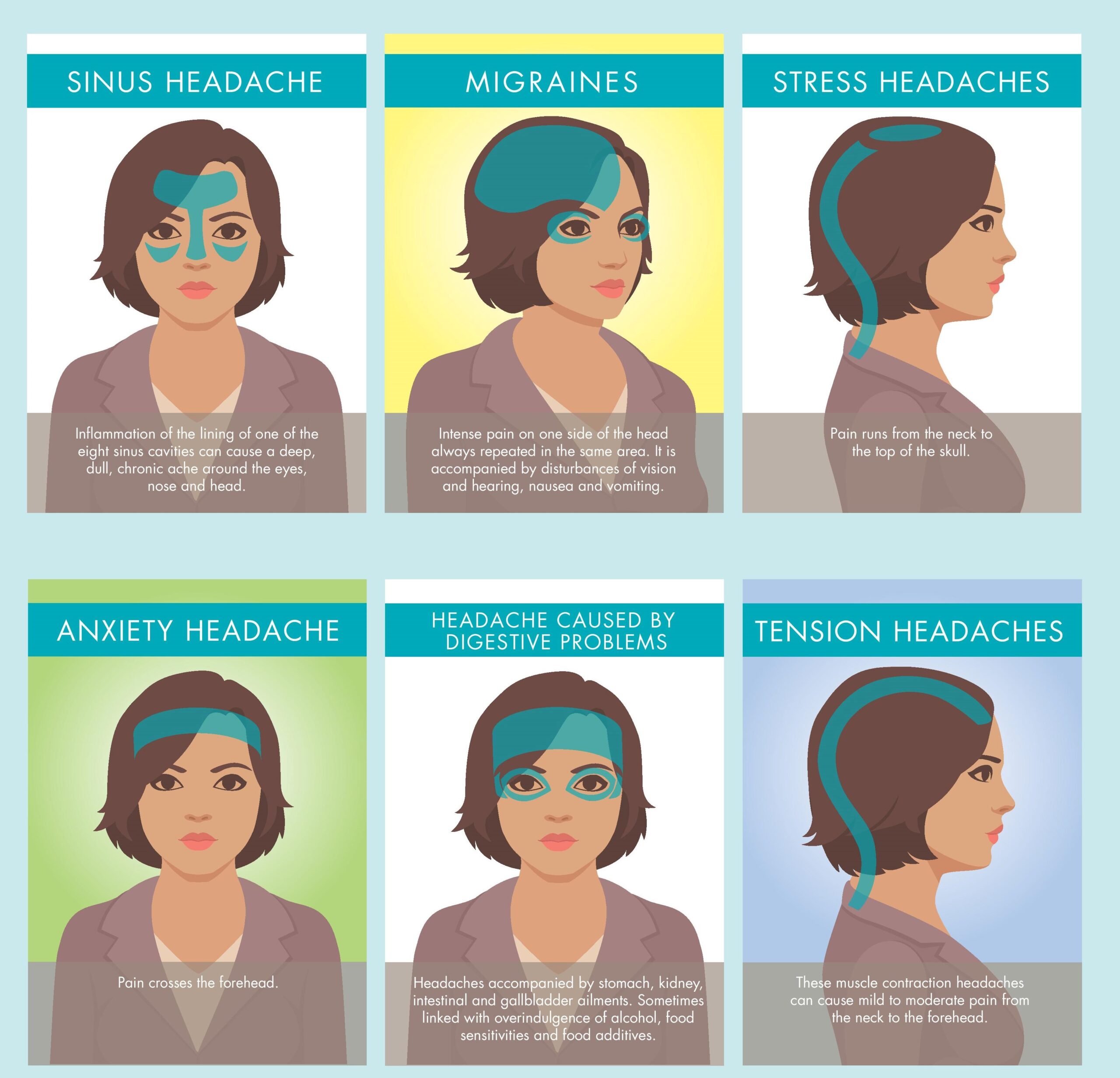Understanding Headaches: Causes and Types
Headaches are a common ailment that can affect anyone, regardless of age or fitness level. They can be caused by various factors, such as stress, tension, dehydration, or underlying medical conditions. There are several types of headaches, including tension headaches, migraines, and cluster headaches. Tension headaches are often described as a tight band around the head, while migraines can cause severe throbbing pain, usually on one side of the head, and are often accompanied by nausea, vomiting, and sensitivity to light and sound. Cluster headaches are a rare type of headache that occurs in clusters, usually affecting one side of the head and causing intense pain around the eye.
Identifying the type of headache is crucial when deciding whether to exercise or not. Generally, working out with a mild headache, such as a tension headache, might be possible, while intense headaches, like migraines or cluster headaches, require rest and proper treatment. Exercising with a headache can sometimes help alleviate symptoms, but it can also worsen them, depending on the individual and the type of headache. Therefore, it’s essential to listen to your body and make informed decisions based on your specific situation.
Assessing the Intensity of Your Headache
Assessing the intensity of a headache is an essential step in determining whether to engage in exercise or not. A headache’s intensity can vary from mild to severe, and the location and duration of the headache can also influence the decision. Mild headaches, such as tension headaches, may not necessarily prevent you from working out, but intense headaches, like migraines or cluster headaches, usually require rest and proper treatment.
To evaluate the intensity of a headache, consider the following factors:
- Pain level: On a scale of 1 to 10, with 1 being barely noticeable and 10 being excruciating, where does your headache fall? Mild headaches (levels 1-3) might allow for light exercise, while moderate to severe headaches (levels 4-10) may necessitate rest.
- Location: Is the headache localized to a specific area or spread across your head? Headaches concentrated in one area might be more manageable during exercise, while widespread headaches may worsen with activity.
- Duration: How long have you been experiencing the headache? If the headache is new or has been persisting for a short period, it might be more appropriate to wait and see if it resolves before exercising. However, if the headache is chronic or recurring, you may need to find ways to exercise around it.
Benefits and Risks of Exercising with a Headache
Exercising with a headache can have both benefits and risks, making it essential to listen to your body and make informed decisions. While some individuals may find relief through exercise, others might experience worsened symptoms or even injury.
Benefits
Exercise can help alleviate headache symptoms by releasing endorphins, the body’s natural painkillers, and promoting relaxation. Some potential benefits of exercising with a headache include:
- Stress relief: Regular exercise can help reduce stress and anxiety, which are common headache triggers.
- Improved mood: Engaging in physical activity can boost your mood and help you feel more positive, even when dealing with a headache.
- Increased focus: Exercise can help clear your mind and improve concentration, making it easier to manage headache-related brain fog.
Risks
Exercising with a headache can also pose risks, particularly if the headache is severe or accompanied by other symptoms. Some potential risks include:
- Increased pain: Vigorous exercise can exacerbate headache symptoms, making the pain more intense or prolonged.
- Dehydration: Exercising while dehydrated can trigger headaches or worsen existing ones. It’s crucial to stay hydrated before, during, and after exercise.
- Injury: If your headache is accompanied by dizziness, disorientation, or weakness, exercising can increase the risk of injury due to reduced coordination and balance.
By understanding both the benefits and risks of exercising with a headache, you can make informed decisions about whether to engage in physical activity or rest and recover.
Alternative Forms of Exercise for Headache Relief
When dealing with a headache, low-impact exercises can help alleviate symptoms and contribute to overall well-being. These exercises can be incorporated into your daily routine or used as alternatives to more intense workouts. Some popular options include:
Yoga
Yoga combines physical postures, breathing exercises, and meditation to promote relaxation and reduce stress. Regular practice can help alleviate tension headaches and improve overall mental health. Additionally, certain yoga poses can target specific areas affected by headaches, such as the neck and shoulders.
Stretching
Gentle stretching can help relieve muscle tension, a common cause of headaches. Focus on stretching the neck, shoulders, and upper back to alleviate tightness in these areas. Be sure to stretch slowly and hold each pose for several seconds to allow your muscles to relax.
Light Walking
A short, brisk walk can help distract from headache pain and promote the release of endorphins. Opt for a flat, quiet route to minimize the risk of injury or exacerbating headache symptoms. Remember to stay hydrated and take breaks as needed.
Incorporating these alternative forms of exercise into your routine can help manage headache symptoms and contribute to overall well-being. Always listen to your body and adjust your exercise intensity as needed to ensure a safe and effective workout.
How to Exercise Safely with a Headache
Exercising with a headache can be challenging, but by following safety tips and modifying your workout routine, you can minimize the risks and potentially alleviate symptoms. Here are some recommendations for exercising safely with a headache:
Stay Hydrated
Dehydration can trigger headaches or worsen existing ones. Ensure you drink enough water before, during, and after exercise to maintain proper hydration levels.
Warm Up and Cool Down Properly
Proper warm-up and cool-down periods can help prevent injury and reduce the risk of headaches. Gradually increase your heart rate during the warm-up and allow your body to recover during the cool-down.
Modify Intensity and Duration
Adjust the intensity and duration of your workout based on your headache symptoms. Opt for lower-intensity exercises and shorter durations when dealing with a headache. Listen to your body and avoid pushing yourself too hard.
Consult a Healthcare Professional
Before starting a new exercise routine, consult a healthcare professional, especially if you frequently experience headaches. A healthcare professional can provide personalized advice and help you create a safe and effective workout plan.
By following these tips, you can exercise safely with a headache and potentially reduce the frequency and severity of your symptoms. Remember, it’s essential to listen to your body and prioritize your well-being above all else.
When to Avoid Exercise with a Headache
While mild headaches might not always prevent you from exercising, certain situations and symptoms warrant rest and recovery. Here are some scenarios when it’s best to avoid exercise with a headache:
Severe Headaches
If you’re experiencing a severe headache, such as a migraine or cluster headache, it’s generally best to avoid exercise and focus on resting and recovering. Engaging in physical activity can worsen the pain and prolong the duration of the headache.
Unusual or Sudden Headaches
If you’re dealing with an unusual or sudden headache, especially if it’s accompanied by other symptoms like vomiting, dizziness, or difficulty speaking, avoid exercise and seek medical attention. These symptoms could indicate a more serious underlying condition.
Headache Triggers
Be aware of your headache triggers and avoid exercise if you suspect it may exacerbate your symptoms. Common triggers include dehydration, bright lights, loud noises, and certain foods or beverages. If exercise is a known trigger for your headaches, consider alternative forms of relaxation and stress relief.
Post-Exertional Headaches
In some cases, exercise can trigger a headache or make an existing one worse. If you frequently experience post-exertional headaches, consult a healthcare professional for personalized advice on managing your symptoms and adjusting your exercise routine.
By understanding when to avoid exercise with a headache, you can prioritize your well-being and minimize the risk of worsening your symptoms. Remember, rest and recovery are crucial components of any exercise plan, especially when dealing with headaches.
Creating an Exercise Plan for Headache Management
Developing an exercise plan that takes headaches into account can help improve your overall well-being and potentially reduce the frequency and severity of your symptoms. Here’s how to create an effective exercise plan for headache management:
Identify Your Headache Patterns
Track your headache patterns and identify any triggers or trends. This information can help you determine the best time to exercise and the types of activities that may alleviate your symptoms. For example, if you frequently experience headaches in the afternoon, consider exercising in the morning to avoid exacerbating your symptoms.
Choose Low-Impact Activities
Opt for low-impact exercises that are less likely to trigger headaches or worsen existing symptoms. Activities such as yoga, swimming, or cycling can provide a good workout while minimizing the risk of headaches.
Adjust Intensity and Duration
Modify the intensity and duration of your workouts based on your headache symptoms. If you’re experiencing a mild headache, you might be able to maintain your regular exercise routine, but with reduced intensity. However, if your headache is more severe, consider taking a break from exercise and focusing on rest and recovery.
Monitor Your Progress
Keep track of your headache symptoms and exercise activities to identify trends and adjust your exercise plan accordingly. Over time, you may notice that certain exercises or routines help alleviate your headaches, while others may exacerbate them. Use this information to fine-tune your exercise plan and optimize your headache management strategy.
By incorporating these strategies into your exercise plan, you can take a proactive approach to headache management and improve your overall well-being. Remember, it’s essential to consult a healthcare professional before starting a new exercise routine, especially if you frequently experience headaches.
Consulting Healthcare Professionals for Personalized Advice
When dealing with headaches, seeking advice from healthcare professionals is crucial for developing a safe and effective exercise plan. Consulting with doctors, physical therapists, or other specialists can help you better understand your headaches and create a personalized approach to managing your symptoms.
Collaborative Approach
Healthcare professionals can work with you to create a comprehensive headache management plan that includes exercise. They can help you identify your headache triggers, assess your fitness level, and recommend appropriate exercises or activities based on your specific needs and limitations.
Expert Guidance
A healthcare professional can provide valuable guidance on exercising safely with a headache. They can help you determine the intensity and duration of your workouts, offer advice on proper warm-up and cool-down techniques, and address any concerns or questions you may have about exercising with headaches.
Monitoring Progress
Healthcare professionals can also help you monitor your progress and adjust your exercise plan as needed. By tracking your headache patterns and exercise activities, you and your healthcare team can identify trends and make informed decisions about your headache management strategy.
Customized Exercise Plans
In some cases, healthcare professionals may recommend specific exercises or routines designed to alleviate headache symptoms. For example, physical therapists can provide personalized stretches and strengthening exercises to help improve posture and reduce tension headaches.
By working closely with healthcare professionals, you can develop a customized exercise plan that takes your headaches into account and promotes overall well-being. Remember, a collaborative approach to headache management is essential for achieving long-term success and improving your quality of life.
https://www.youtube.com/watch?v=nJ84360do7Y







